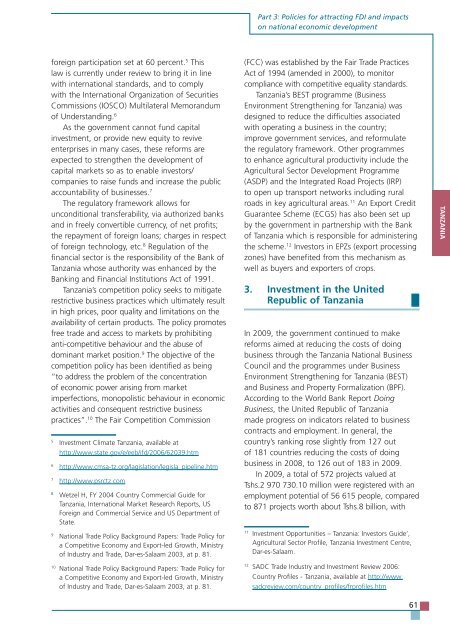TRENDS AND IMPACTS OF FOREIGN INVESTMENT IN DEVELOPING COUNTRY AGRICULTURE
TRENDS AND IMPACTS OF FOREIGN INVESTMENT IN DEVELOPING COUNTRY AGRICULTURE
TRENDS AND IMPACTS OF FOREIGN INVESTMENT IN DEVELOPING COUNTRY AGRICULTURE
You also want an ePaper? Increase the reach of your titles
YUMPU automatically turns print PDFs into web optimized ePapers that Google loves.
foreign participation set at 60 percent. 5 This<br />
law is currently under review to bring it in line<br />
with international standards, and to comply<br />
with the International Organization of Securities<br />
Commissions (IOSCO) Multilateral Memorandum<br />
of Understanding. 6<br />
As the government cannot fund capital<br />
investment, or provide new equity to revive<br />
enterprises in many cases, these reforms are<br />
expected to strengthen the development of<br />
capital markets so as to enable investors/<br />
companies to raise funds and increase the public<br />
accountability of businesses. 7<br />
The regulatory framework allows for<br />
unconditional transferability, via authorized banks<br />
and in freely convertible currency, of net profits;<br />
the repayment of foreign loans; charges in respect<br />
of foreign technology, etc. 8 Regulation of the<br />
financial sector is the responsibility of the Bank of<br />
Tanzania whose authority was enhanced by the<br />
Banking and Financial Institutions Act of 1991.<br />
Tanzania’s competition policy seeks to mitigate<br />
restrictive business practices which ultimately result<br />
in high prices, poor quality and limitations on the<br />
availability of certain products. The policy promotes<br />
free trade and access to markets by prohibiting<br />
anti-competitive behaviour and the abuse of<br />
dominant market position. 9 The objective of the<br />
competition policy has been identified as being<br />
“to address the problem of the concentration<br />
of economic power arising from market<br />
imperfections, monopolistic behaviour in economic<br />
activities and consequent restrictive business<br />
practices”. 10 The Fair Competition Commission<br />
5 Investment Climate Tanzania, available at<br />
http://www.state.gov/e/eeb/ifd/2006/62039.htm<br />
6 http://www.cmsa-tz.org/lagislation/legisla_pipeline.htm<br />
7 http://www.psrctz.com<br />
8 Wetzel H, FY 2004 Country Commercial Guide for<br />
Tanzania, International Market Research Reports, US<br />
Foreign and Commercial Service and US Department of<br />
State.<br />
9 National Trade Policy Background Papers: Trade Policy for<br />
a Competitive Economy and Export-led Growth, Ministry<br />
of Industry and Trade, Dar-es-Salaam 2003, at p. 81.<br />
10 National Trade Policy Background Papers: Trade Policy for<br />
a Competitive Economy and Export-led Growth, Ministry<br />
of Industry and Trade, Dar-es-Salaam 2003, at p. 81.<br />
Part 3: Policies for attracting FDI and impacts<br />
on national economic development<br />
(FCC) was established by the Fair Trade Practices<br />
Act of 1994 (amended in 2000), to monitor<br />
compliance with competitive equality standards.<br />
Tanzania’s BEST programme (Business<br />
Environment Strengthening for Tanzania) was<br />
designed to reduce the difficulties associated<br />
with operating a business in the country;<br />
improve government services, and reformulate<br />
the regulatory framework. Other programmes<br />
to enhance agricultural productivity include the<br />
Agricultural Sector Development Programme<br />
(ASDP) and the Integrated Road Projects (IRP)<br />
to open up transport networks including rural<br />
roads in key agricultural areas. 11 An Export Credit<br />
Guarantee Scheme (ECGS) has also been set up<br />
by the government in partnership with the Bank<br />
of Tanzania which is responsible for administering<br />
the scheme. 12 Investors in EPZs (export processing<br />
zones) have benefited from this mechanism as<br />
well as buyers and exporters of crops.<br />
3. Investment in the United<br />
Republic of Tanzania <br />
In 2009, the government continued to make<br />
reforms aimed at reducing the costs of doing<br />
business through the Tanzania National Business<br />
Council and the programmes under Business<br />
Environment Strengthening for Tanzania (BEST)<br />
and Business and Property Formalization (BPF).<br />
According to the World Bank Report Doing<br />
Business, the United Republic of Tanzania<br />
made progress on indicators related to business<br />
contracts and employment. In general, the<br />
country’s ranking rose slightly from 127 out<br />
of 181 countries reducing the costs of doing<br />
business in 2008, to 126 out of 183 in 2009.<br />
In 2009, a total of 572 projects valued at<br />
Tshs.2 970 730.10 million were registered with an<br />
employment potential of 56 615 people, compared<br />
to 871 projects worth about Tshs.8 billion, with<br />
11 Investment Opportunities – Tanzania: Investors Guide’,<br />
Agricultural Sector Profile, Tanzania Investment Centre,<br />
Dar-es-Salaam.<br />
12 SADC Trade Industry and Investment Review 2006:<br />
Country Profiles - Tanzania, available at http://www.<br />
sadcreview.com/country_profiles/frprofiles.htm<br />
61<br />
TANZANIA


